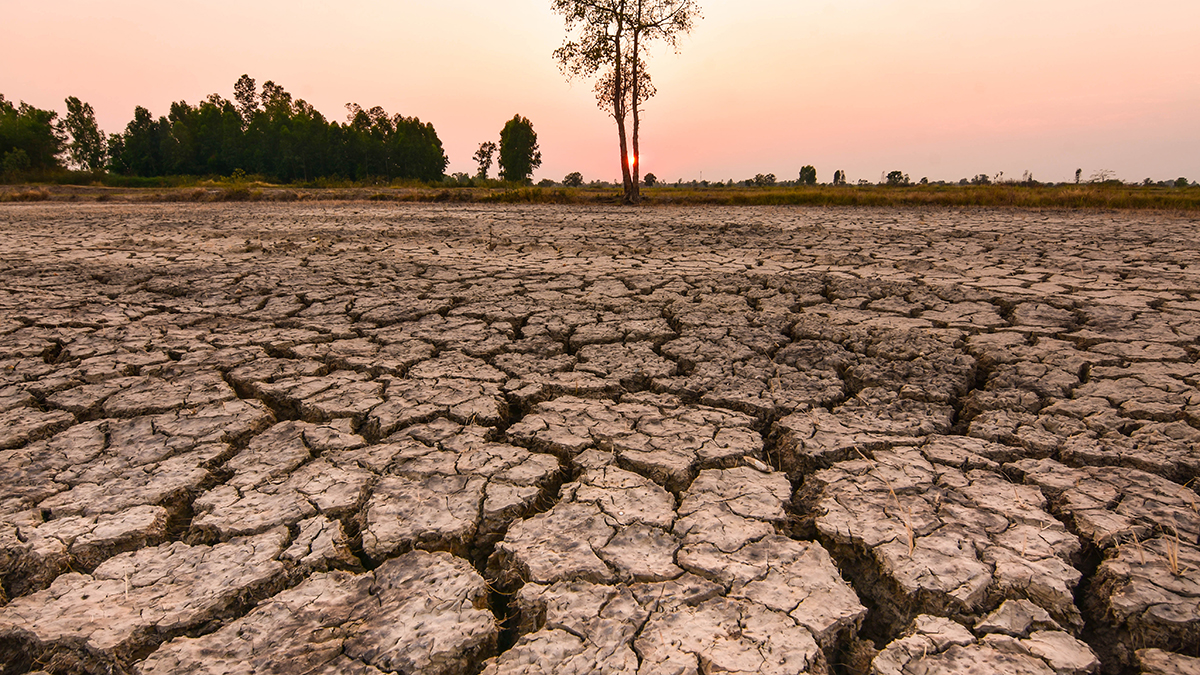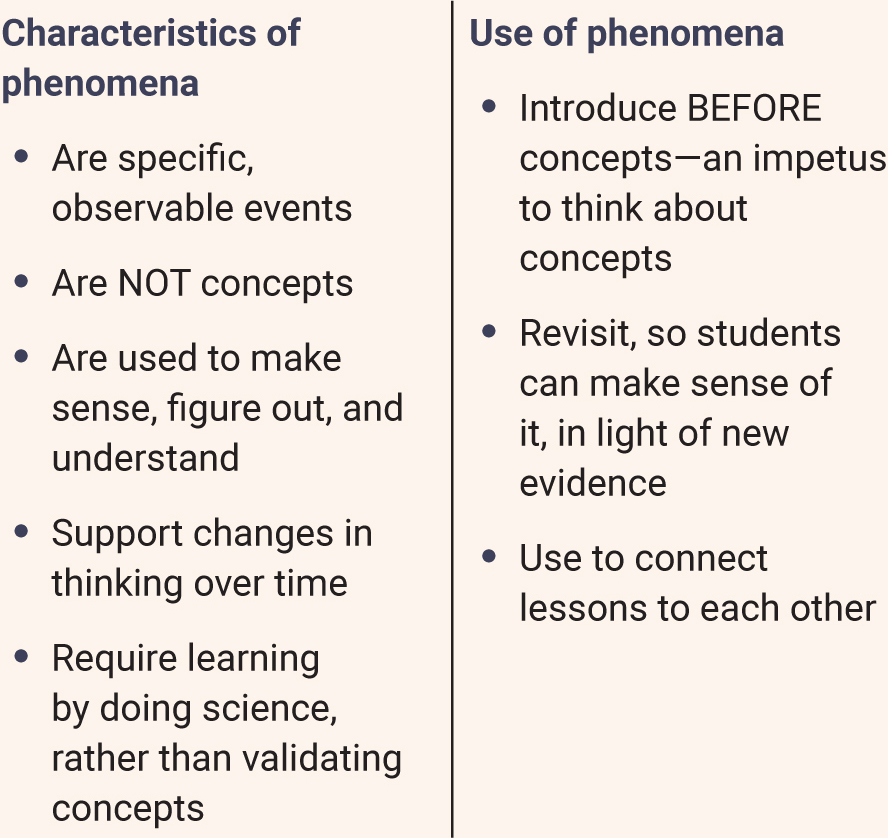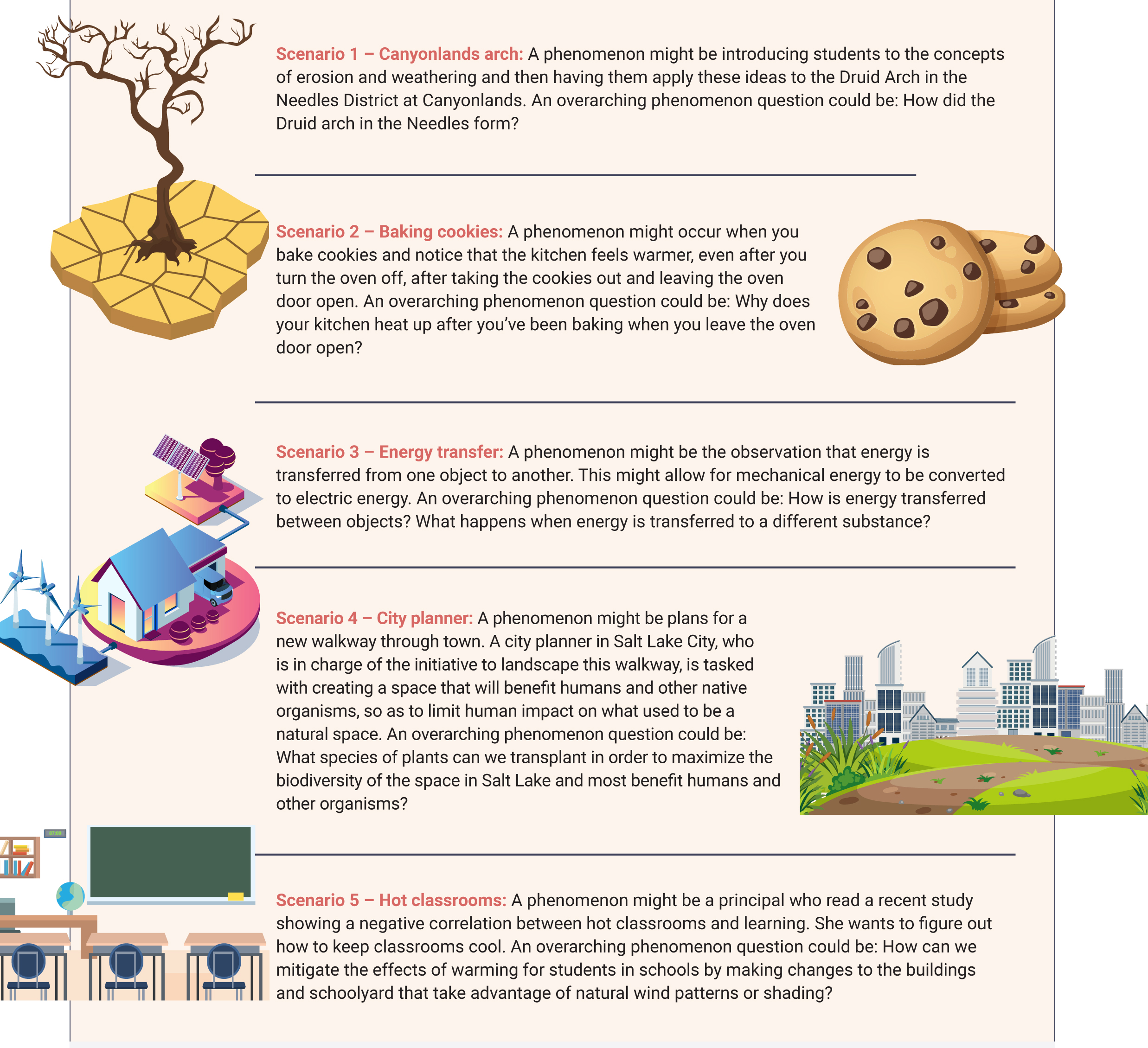feature
Beyond the Hook
What is a phenomenon and how is it used?
The Science Teacher—July/August 2020 (Volume 87, Issue 9)
By Martha Inouye, Ana Houseal, and Clare Gunshenan

A colleague comes to you, excited about the idea of using phenomena in their science classroom, and wants to know your thoughts. “We’re starting a unit on cells” they say, “so I’m going to show this video of a white blood cell chasing and eating a bacterium. Then, I’ll talk to them about how different cells combine to make body systems, including the immune system. I think the video will get them hooked.”
How do you respond? You may be thinking they’re on target in using the video as a phenomenon, or you may be skeptical. We would argue that it is not a phenomenon. This article explores the characteristics and uses of phenomena through examples and non-examples, illustrating why this example is not.
Recent research on science teaching and learning defines science as both a body of knowledge and a process (NRC 2007); it is the integration of science content, practices, and core ideas (NRC 2012). It would follow that science learning should parallel what science is and how it is done; students should not be just consumers of scientific knowledge, but also producers who engage in scientific processes to acquire deeper understanding. Instructing with phenomena provides opportunities for students to do and learn science.
Recent efforts to teach science in authentic ways has resulted in a flurry of curricular resources and instructional briefs that use phenomena as the basis for good science instruction (e.g., Achieve; Ambitious Science Teaching; ). As such, an internet search for phenomenon +NGSS results in websites with lists of GIFs, videos, and suggestions. But what are phenomena and how should they be used to support science learning? While readily accessible, an Internet search may not be providing phenomena that will work in the context of NGSS-aligned instruction.
What is a phenomenon?
To learn science is to learn how to be a scientist: taking part in knowledge creation through scientific practices to explore the built and natural world, in an effort to increase understanding. Ford (2008) argued that learning scientific ideas with understanding comes from using the science practices to construct and critique knowledge claims with others, in reference to how these claims connect to what they observe of nature’s behavior. The National Research Council summarizes this idea by stating that “[s]tudents learn best when actively engaging in the practices of science…” and that discourse is “key to supporting learning in science [because] explanation rather than facts is the goal of the scientific enterprise” (NRC 2007, p. 251).
Phenomena provide contexts in which students can actively engage in science and science discourse. At its core, a phenomenon is a means to help students learn and do science by using available data to construct claims about what is happening, and by critiquing claims in light of the behavior of nature, as a community. Through this process, students acquire a deeper understanding of science concepts, science practices, and crosscutting concepts. To undergo this process of constructing and critiquing knowledge, phenomena must embody certain characteristics and be used in specific ways (Figure 1).

The characteristics and uses of phenomena for science instruction.
We’ll use the scenarios in Figure 2 to illustrate these characteristics and uses. Take a moment to read them. Based on Figure 1, decide if each scenario (a) is a phenomenon, (b) represents a phenomenon with an engineering design component, or (c) is not a phenomenon. Delineating an engineering design challenge can be useful for distinguishing between phenomena that support the engineering standards and practices and those that do not.

Scenarios of potential phenomena.
A phenomenon must be a specific, observable event
In Figure 2, look at Scenarios 2—Baking Cookies and 3—Energy Transfer. Both require an understanding of energy transfer and atomic molecular theory, but a phenomenon must present a specific scenario. The difference between these two is that one provides a specific event (feeling the kitchen warm up after the oven is turned off), while the other describes a scientific concept (energy is transferred from one object to another) without an observable event. In order to make sense of something, students must have something with which to make sense. The notion of energy transfer is not an event, nor does it necessitate question or idea generation or a reason for figuring out the scientific concepts underlying energy transfer.
A concept is not a phenomenon
All phenomena require an understanding of science concepts. For example, to explain the rock arches in Scenario 1—Canyonlands arch, students must understand and apply the concepts of erosion, weathering, and geologic formation. Similarly, Scenarios 2—Baking Cookies, 4—City Planner, and 5—Hot Classrooms require conceptual knowledge of energy transfer, biodiversity, ecosystem interactions, disturbance, human impact, and/or engineering. However, a phenomenon is not the concept itself.
A phenomenon connects to targeted concepts
No matter how engaging and relevant, a phenomenon will not support instruction and student learning if it does not connect to the unit’s standards. Does the phenomenon require understanding of the standards’ embedded concepts? Is the phenomenon appropriately complex to meet the grade level needs of students? If either answer is “no,” then the phenomenon needs to be reworked. As an example, consider Scenario 2—Baking Cookies. Increasing the complexity of this phenomenon by adding a variable, such as high-altitude baking, could enable high school students to engage in deeper thinking about energy transfer and other scientific concepts. Exploring differences in baking at high vs. low altitudes requires understanding of energy transfer as well as atmospheric pressure’s impact on boiling points, rates of evaporation, and expansion of gases in leavening. This would allow high school students to grasp these ideas at the molecular level.
Phenomena are used to make sense and connect lessons to each other
Given that science concepts need to be applied to make sense of phenomena, large anchoring phenomena (For States, By States 2016) can provide a broad and complex context for students. Scientists face uncertainty when they observe something that they cannot initially explain; through the use of scientific practices and reasoning, they can make sense of that observation. For students, uncertainty emerges when they seek to understand a phenomenon, decide how to approach investigating it, and identify the explanations they can draw from those investigations (Manz 2015).
By putting these pieces of investigation together, students confront uncertainty just as scientists do, and are forced to make connections to their daily lessons. In this way, anchoring phenomena in the classroom allow students to engage in a similar process: to employ and reason with content (DCIs), practices (SEPs), and crosscutting concepts (CCCs), as they seek to make sense of the phenomenon (i.e., resolve uncertainty).
Take, for example, Scenario 5—Hot Classrooms. To figure out a solution for this design challenge phenomenon, students must grapple with the uncertainty of what might be contributing to the classroom climate, what affects how we learn, and how they might change that climate accordingly. Along the way, they will investigate body systems (nervous system), the science of learning, and concepts related to regional weather patterns, energy transfer, and effects of temperature on building materials. To address the engineering component of the phenomenon, students would need to identify criteria and constraints of a design solution.
The placement of the phenomenon matters
The NGSS encourages students to engage in three-dimensional learning by building conceptual understanding while making sense of something they observe. In Scenario 1—Canyonlands arch, students are introduced to scientific concepts before applying them. This form of frontloading does not allow students to authentically investigate in order to produce scientific knowledge. Rather, students transfer didactic knowledge to a scenario, which requires the skills of critical analysis, but not engagement in true scientific thinking because this application simply confirms concepts with post hoc application. While the transference of knowledge is pertinent, a phenomenon should require investigative participation in gaining that knowledge first.
Thus, to make the Scenario 1—Canyonlands arch a phenomenon, students would initially need to be given visuals of the unique rock formation to make observations and generate questions about their formation observations. This provides students with an opportunity to wonder and share their claims and reasoning for how the arch was formed. Subsequent activities would deepen students’ understanding of associated concepts in an effort to make sense of these observations; i.e., to do science.
In Scenarios 2—Baking Cookies, 4—City Planner, and 5—Hot Classrooms, students are presented with the event and generate their own observations and questions to initiate the unit, prior to exploring the concepts. During the subsequent instructional sequence, student questions are not connected to lessons at random, but instead carefully selected by the teacher to match the storyline they created to build coherence within the learning sequence.
Relevance matters: My kids don’t know anything about Salt Lake City
Relevance and emotional connections to concepts are integral to learning (Immordino-Yang and Damasio 2007), so students need to be able to personally connect to phenomena. The scenarios above can easily be modified to make them more local and relevant for students. Instead of using the Druid arch in Canyonlands (Scenario 1), a teacher might introduce a prominent local or regional rock formation. In this way, students can attach experiences and/or emotion to it. Rather than a city planner in Salt Lake City (Scenario 4), students might recommend solutions to issues in their community or discuss recent news articles they find intriguing. Modifying phenomena to be more relevant to students, both in location and topic, will support buy-in, engagement, and deeper learning.
Revisiting a phenomenon
If using a phenomenon prompts students to make sense of science concepts that explain it, how often do they need to revisit the phenomenon? Without revisiting, there are no opportunities for students to connect new evidence and new understanding from investigations. “Durable learning requires time…for mental rehearsal … The increased effort to retrieve learning after a little forgetting has the effect of retriggering consolidation, further strengthening memory.” (Brown, Roediger, and McDaniel 2014, p. 49). It is imperative to provide opportunities to revisit a phenomenon to revise claims, make sense of it, and build the retrieval skills for long-term memory.
In practice, consider a student perspective. If you were asked to revise your model or explanation of a phenomenon after every lesson over a three-week period, how would you react? You would likely become fatigued. You also might not have much to add for each iteration. Instead, consider this sequence: You are introduced to a phenomenon at the beginning of a unit to generate initial ideas and questions, engage in three different lessons about related concepts, and then return to the phenomenon to revise your ideas. The fatigue might not emerge and you would have multiple pieces of new evidence to compare to your initial ideas.
Research supports this idea, finding that models should be revised only once or twice in the middle of a unit with a consensus model at the end (Windschitl and Thompson 2013). A phenomenon that is used within the context of a single lesson instead of a full unit should bookend the lesson. This way, students can solidify their understanding by contextualizing what they figured out.
What about engineering?
What differs between phenomena that support engineering practices and those that do not? Consider Scenarios 4—City planner and 5—Hot Classrooms. Both scenarios are presented in a manner that promotes student thinking about a solution to a problem (landscaping to maintain biodiversity or actions to limit classroom warming). The engineering standards and practices are intended to support students in “[aspiring] to solve major societal and environmental challenges they will face in the decades ahead” (NGSS Lead States 2013, Appendix I, p.1). The selection and framing of phenomena that require students to solve problems can facilitate this type of thinking.
Conclusion
With all of this in mind, revisit your colleague’s initial idea about the cell phenomenon. Cells combining to make body systems is a fundamental biological concept. Even though the immune system is under discussion, the way it is presented does not inherently promote wonder about a specific event. If instead, your colleague proposed a phenomenon in the form of a case study about a man with a disease affecting his pancreas, it would work better. The latter scenario requires students to wonder, then investigate several questions to figure out what is happening Revisiting the case study halfway through and at the end of the unit allows students to attach new learning to their initial claims.
Scenarios 2—Baking cookies, 4—City planner, and 5—Hot Classrooms all afford students opportunities to wonder about and investigate phenomena, with the last two including an engineering design component. Most importantly, they provide an opportunity for students to engage in the processes that scientists use to acquire scientific knowledge: they are figuring out, not validating. This can only be achieved by revisiting each phenomenon after new learning has happened.
Of import, none of these would be considered phenomenal phenomena. Although an Internet search is likely to generate flashy videos or GIFs, a phenomenon can be effective without all the bells and whistles. While student engagement is key, the flashy hooks used in science in the past will not necessarily work. Likewise, some online examples are not complex enough to have students engage in more than providing a simple explanation. Phenomena need to provide relevant and complex contexts to consider and attach prior knowledge, scientific concepts, and new learning. So, when you are looking for phenomena for your science units, lessons, and activities, evaluate them for the characteristics in this article and consider the ways you will use them to drive instruction, student learning, and students’ active engagement in science.
Martha Inouye (minouye@uwyo.edu) is an assistant research scientist, Ana Houseal (ahouseal@uwyo.edu) is an associate professor, and Clare Gunshenan (cgunshen@uwyo.edu) is an outreach educator, all at University of Wyoming – Science and Mathematics Teaching Center in Laramie, Wyoming.


